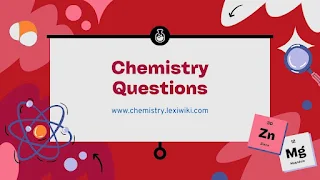Questions on Electron Configurations
20 Multiple-Choice Questions — Electron Configurations
1. What is the electron configuration of a neutral oxygen atom (atomic number 8)?
A) 1s² 2s² 2p⁴
B) 1s² 2s² 2p²
C) 1s² 2s² 2p⁶
D) 1s² 2s² 2p³
E) 1s² 2s² 3p⁴
2. Which element has the electron configuration 1s² 2s² 2p⁶ 3s² 3p⁶ 4s¹?
A) Calcium
B) Potassium
C) Sodium
D) Magnesium
E) Chlorine
3. How many total electrons are in the electron configuration 1s² 2s² 2p⁶ 3s² 3p⁵?
A) 15
B) 16
C) 17
D) 18
E) 19
4. Which of the following elements has a completely filled p-subshell in its ground state?
A) Nitrogen
B) Oxygen
C) Neon
D) Fluorine
E) Carbon
5. Which is the correct electron configuration for the magnesium ion, Mg²⁺?
A) 1s² 2s² 2p⁶ 3s²
B) 1s² 2s² 2p⁶
C) 1s² 2s² 2p⁵
D) 1s² 2s² 2p⁶ 3s¹
E) 1s² 2s² 2p⁴
6. What is the noble gas configuration for chlorine (atomic number 17)?
A) [Ne] 3s² 3p⁵
B) [He] 2s² 2p⁶ 3s² 3p⁵
C) [Ar]
D) [Ne] 3s² 3p⁶
E) [He] 2s² 2p⁶ 3p⁵
7. What is the electron configuration for Al³⁺ (aluminum ion)?
A) 1s² 2s² 2p⁶ 3s² 3p¹
B) 1s² 2s² 2p⁶
C) 1s² 2s² 2p⁵
D) 1s² 2s² 2p⁶ 3s¹
E) 1s² 2s² 2p⁶ 3p³
8. Which orbital is filled after 3p in the Aufbau Principle order?
A) 3d
B) 4s
C) 4p
D) 5s
E) 3s
9. How many electrons are in the 3d subshell of iron (Fe), atomic number 26?
A) 4
B) 5
C) 6
D) 8
E) 10
10. Which of the following ions has the same electron configuration as neon?
A) O²⁻
B) F⁻
C) Na⁺
D) All of the above
E) None of the above
11. Which rule states that no two electrons can have the same set of quantum numbers?
A) Hund's Rule
B) Octet Rule
C) Pauli Exclusion Principle
D) Aufbau Principle
E) Bohr's Rule
12. The element with configuration 1s² 2s² 2p⁶ 3s² 3p⁶ 3d⁵ 4s¹ is:
A) Iron
B) Manganese
C) Chromium
D) Nickel
E) Cobalt
13. What is the ground-state configuration of a sulfur atom (atomic number 16)?
A) 1s² 2s² 2p⁶ 3s² 3p⁴
B) 1s² 2s² 2p⁶ 3s² 3p³
C) 1s² 2s² 2p⁶ 3s² 3p⁵
D) 1s² 2s² 2p⁶ 3s² 3p⁶
E) 1s² 2s² 2p⁶ 3s¹ 3p⁵
14. Which configuration represents an excited state of an electron?
A) 1s² 2s² 2p⁶
B) 1s² 2s² 2p⁶ 3s¹
C) 1s² 2s² 2p⁵ 3s¹
D) 1s² 2s² 2p⁶ 3s²
E) 1s² 2s² 2p⁶ 3s² 3p⁶
15. What is the last orbital filled in the electron configuration of bromine (atomic number 35)?
A) 4s²
B) 4p⁵
C) 3d¹⁰
D) 5s²
E) 4d¹⁰
16. Which of the following elements has a half-filled d-subshell in its ground state?
A) Fe
B) Zn
C) Mn
D) Cu
E) Ni
17. Which ion has an electron configuration of 1s² 2s² 2p⁶?
A) Mg²⁺
B) O²⁻
C) F⁻
D) All of the above
E) Only A and C
18. How many valence electrons does phosphorus (atomic number 15) have?
A) 3
B) 4
C) 5
D) 6
E) 7
19. What is the electron configuration of calcium (atomic number 20)?
A) [Ar] 4s²
B) [Ne] 3s² 3p⁶ 4s²
C) [He] 2s² 2p⁶ 3s² 3p⁶ 4s²
D) All of the above
E) Only A and B
20. Which of the following represents the correct order of orbital filling?
A) 1s → 2s → 2p → 3s → 3p → 4s → 3d
B) 1s → 2s → 2p → 3s → 3p → 3d → 4s
C) 1s → 2s → 2p → 3s → 4s → 3p → 3d
D) 1s → 2p → 2s → 3p → 3s
E) 1s → 2s → 3s → 2p → 4s → 3p
- Questions on Aufbau Principle
- Questions on Pauli Exclusion Principle
- Questions on Hund's Rule and Orbital Filling Diagrams
Answers and Explanations:
1. A – Oxygen has 8 electrons: 1s² 2s² 2p⁴.
2. B – Potassium is 19: ends with 4s¹.
3. C – Total electrons = 17 (Chlorine).
4. C – Neon has full p-shell: 2p⁶.
5. B – Mg loses 2 electrons: 1s² 2s² 2p⁶.
6. A – [Ne] 3s² 3p⁵ = 17 electrons.
7. B – Al³⁺ loses 3 electrons → 1s² 2s² 2p⁶.
8. B – After 3p, 4s is filled before 3d.
9. C – Iron: [Ar] 4s² 3d⁶ → 6 in 3d.
10. D – All have 10 electrons = Ne.
11. C – Pauli Exclusion = no two same quantum numbers.
12. C – Chromium is exception: 3d⁵ 4s¹.
13. A – Sulfur has 16 electrons → ends in 3p⁴.
14. C – 2p⁵ 3s¹ is an excited state (not lowest energy).
15. B – Br ends in 4p⁵.
16. C – Mn has 3d⁵ (half-filled d).
17. D – All are isoelectronic with Ne (10 electrons).
18. C – Phosphorus: [Ne] 3s² 3p³ → 5 valence electrons.
19. D – All represent calcium (20 electrons).
20. A – This is the correct Aufbau sequence.
Dive into the groundbreaking science of neurotransmitters—your brain’s invisible architects—in Chemical Harmony: How Neurotransmitters Shape Our Lives (2025). This meticulously researched book reveals how serotonin, dopamine, GABA, and other brain chemicals silently orchestrate every aspect of your existence, from decision-making and relationships to mental health and emotional resilience.Click here to buy
Share Online!

